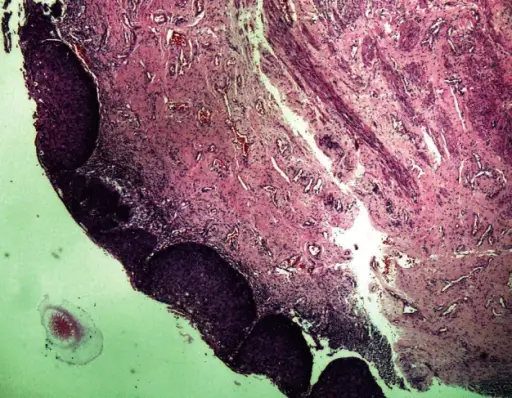Squamous cell carcinoma of the vagina is cancer that forms in the thin, flat cells lining the inside of the vagina.
What is the Pathology of Vaginal Squamous Cell Carcinoma?
The pathology of vaginal squamous cell carcinoma is:
-Etiology: The cause of vaginal squamous cell carcinoma is infection with the human papillomavirus, or HPV.
-Genes involved: Mutations in TP53, CDKN2A, PIK3CA, NOTCH1, and KMT2D.
-Pathogenesis: The sequence of events that lead to vaginal squamous cell carcinoma is metaplasia and proliferation of atypical cells.
Morphology: The morphology associated with vaginal squamous cell carcinoma shows Exophytic or ulcerative with necrosis.
-Histology: The histology associated with vaginal squamous cell carcinoma shows cells from well differentiated to undifferentiated tumors.
How does Vaginal Squamous Cell Carcinoma Present?
Patients with vaginal squamous cell carcinoma typically females from 58 to 68 years of median age. The symptoms, features, and clinical findings associated with vaginal squamous cell carcinoma include: Unusual vaginal bleeding, watery discharge, lumps in vagina, frequent and painful urination, pelvic pain.
How is Vaginal Squamous Cell Carcinoma Diagnosed?
Vaginal squamous cell carcinoma is diagnosed by biopsy, physical examination, colposcopy, radiological imaging required to determine extent of disease and to look for distant metastasis.
How is Vaginal Squamous Cell Carcinoma Treated?
Vaginal squamous cell carcinoma is treated by radiation therapy, interstitial brachytherapy, intracavitary brachytherapy, chemotherapy and surgical resection.
What is the Prognosis of Vaginal Squamous Cell Carcinoma?
The prognosis of vaginal squamous cell carcinoma is fair. Overall, the 5-year survival rate for women with vaginal cancer is 49%. The cancer diagnosed at early stages is more likely to be cured.



